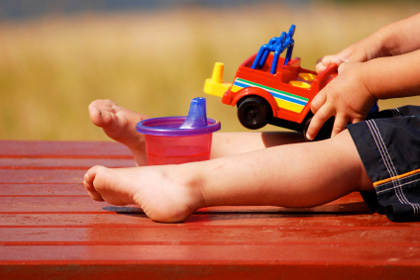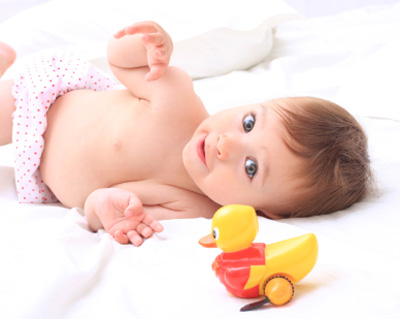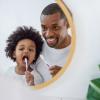 We’ve all heard about toxic toys. But, is your child playing with them? And just how dangerous are they?
We’ve all heard about toxic toys. But, is your child playing with them? And just how dangerous are they?
Bellingham mom Lisa Campbell always looks for playthings that seem safe. “I’m a huge fan of Melissa and Doug’s wooden toys, because I know I don’t have to worry about harmful toxins in or on the toys,” she says.
Toxic toys contain chemicals that, with enough exposure, have proven harmful to laboratory animals or humans. Three chemicals prompt the most concern: lead, phthalates and bisphenol A (BPA).
Lead, a metal widely known for its use in house paints, is primarily found in paint on foreign-manufactured toys and in toys made of polyvinyl chloride (PVC). Polyvinyl chloride can leach phthalates as well as lead.
Campbell worries about toys with lead. “I avoid ‘made in China’ at all costs with toys, particularly for my 20-month-old son, who’s still putting things in his mouth,” she says.
Campbell’s worries aren’t unfounded. In 2007, Mattel recalled 83 toy products made in China because they were covered with lead paint. That same year, the Consumer Product Safety Commission (CPSC) recalled 24 Chinese-made toy products because of lead paint and other hazards.
Why lead’s dangerous for kids
“Lead poisoning is a real issue,” says Marcel Casavant, M.D., medical director of the Central Ohio Poison Center. “It clearly hurts kids — and is fatal to kids in the United States about once or twice every 10 years.”
Lead disrupts the chemistry in the kidneys, brain and bones, which can harm bone and tooth production, and lead to learning disabilities, reduced mental capacity and kidney failure. Children who swallow large amounts of lead by eating chips of old house paint can develop blood anemia, severe stomachaches, muscle weakness and brain damage, according to the Centers for Disease Control and Prevention (CDC).
The CDC and the CPSC list toys that have been recalled because of lead content (see link below). “Besides lead in paint and in gasoline, toys [containing lead] have been an important hazard causing real, clearly documented lead poisoning in kids,” Casavant says. “Young kids should not be allowed to have or play with lead toys.”
Simply holding a lead toy for a few seconds would have no toxic effects, he says, but swallowing a lead toy could be fatal. “But there’s really no way to guarantee a safe exposure — so don’t let kids play with lead,” he says.
Phthalate fears
Phthalates show up in teething rings, pacifiers and flexible plastic toys. They’re used to retain the strength and resiliency of plastics while allowing them to bend. Phthalates leach from finished products when handled by children, especially through chewing and sucking, according to a 1998 CPSC study.
Some types of phthalates have affected the reproductive systems of laboratory animals, according to the CDC, although it reports that the health effects from low levels of phthalates are unknown. “No one would argue that having measurable levels of phthalates in our blood and urine is a particularly good thing for people, but whether we’re suffering adverse effects is more controversial,” says Casavant. While he’d encourage manufacturers to replace phthalates and use something safer, he’d discourage parents from worrying about them.
BPA: It’s in us
Bisphenol A (BPA) is found in many plastic toys, but is best known for its presence in plastic bottles and can liners for canned foods. “I worry about toxins from bottles and cups, and only buy BPA-free bottles and cups,” says Lynnwood mom Gabrielle Del Regno. BPA does find its way into our bodies, according to several studies. The CDC says it doesn’t know the extent of the human health effects of BPA exposure, and notes that more research is needed.
As for dangerous levels of exposure, “Unless the child is eating the plastic, or chewing or sucking on it, it’s hard to imagine significant BPA exposure,” says Casavant, adding that he’s not aware of any BPA poisonings caused by toys.
BPA was in the news when it was discovered in baby bottles. A 2008 National Institutes of Health study found that BPA imitates estrogen in the body. “It’s pretty clear BPA is not beneficial to kids, but there’s real controversy over whether it’s actually bad for kids — or for the rest of us,” says Casavant. “Exposure to BPA is pretty universal in the U.S. and worldwide.”
 Just how toxic is it? No one’s really sure. “I’d encourage toy makers to replace BPA with less potentially toxic materials, but not encourage parents to be worried about it,” he says.
Just how toxic is it? No one’s really sure. “I’d encourage toy makers to replace BPA with less potentially toxic materials, but not encourage parents to be worried about it,” he says.
What to worry about
Casavant contends that most potential hazards from toys don’t, in fact, come from toxins. They come from small parts that can create a choking hazard and cause harm or even prove fatal. Playthings that have points, sharp edges or projectiles can also hurt children, and toys with button batteries can be dangerous. “If the battery enters the child — nose, ear, food pipe or windpipe, or elsewhere — the battery can cause a severe burn in a matter of hours,” says Casavant.
Toys containing small magnets pose a special hazard. “If two magnets, or a magnet with another piece of metal are swallowed, some loops of bowel can get trapped between them. Several children have required emergency operations to remove lengths of intestines which have basically died due to the entrapment between magnets,” Casavant says.
What’s more, computer and video game toys can contribute to inactivity and obesity. Loud toys can cause hearing loss.
What’s the takeaway message? Yes, your child’s playthings can present definite dangers, but except for lead and a few other exceptions, toy toxicity could be the least of your toy troubles.
Maria Bellos Fisher is a freelance writer and mother. Her blog, Hereditary Insanity, is at mariabellosfisher.com/blog.
Finding green toys in the Seattle area
Are you concerned about toxic toys? Good news! You can find a wide selection of “green” toys at any of the following toy stores in our area.
|
Seattle 2nd Base Sporting Goods, Seattle |
Eastside, Tacoma, Beyond ChildTrek Toys, Tacoma |











